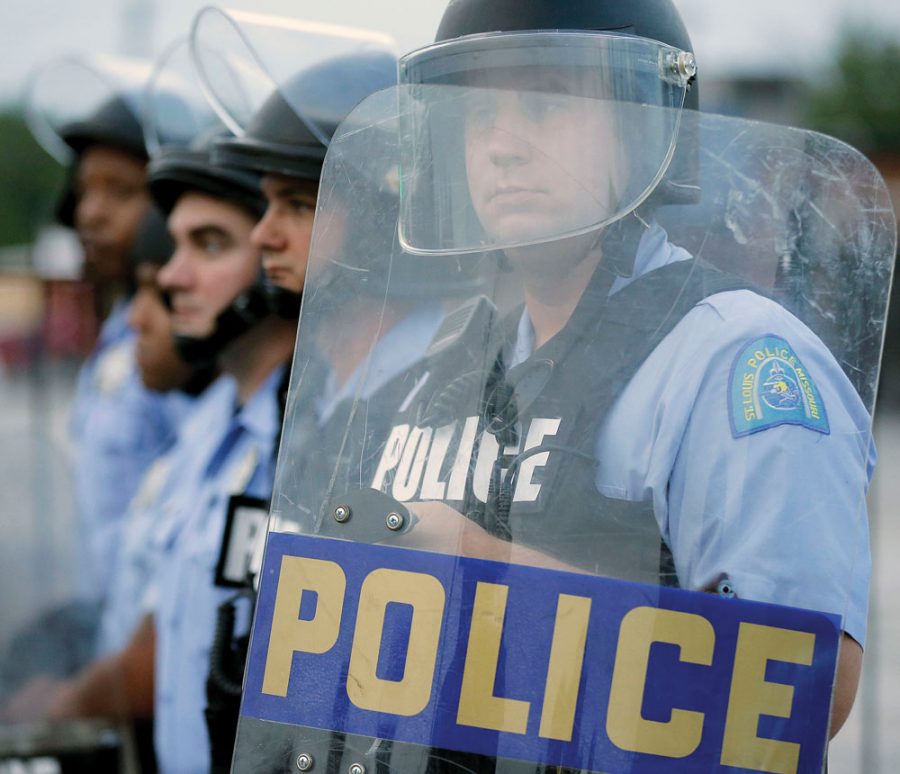One minute past noon on August 9, Ferguson police officer Darren Wilson shot and killed a young black male. His name was Michael Brown. He was 18 and unarmed.
A span of four hours passed between the time that Brown fell to the ground and when personnel arrived to take him away. In those 240 minutes, Brown’s lifeless body remained in public view, partially uncovered and left like forgotten trash on the asphalt of Canfield Drive. The utter disrespect shown to his body was the first divergence from standard protocol committed by the Ferguson Police Department and signaled the start of two weeks of irresponsible behavior on the part of members of forces sworn to serve and protect.
Members of the community constructed a memorial on the spot where Michael Brown was shot to remember a boy who had just graduated from high school and planned to begin college in just a few days.
During the next couple weeks, protesters fed up with reading about the death of yet another young black male, gathered in the streets of Ferguson. Anger quickly built as questions concerning which officer had killed Brown remained unanswered. National news media arrived in Ferguson, capturing images of hundreds marching through the city, chanting a collective mantra of “hands up, don’t shoot.”
When darkness came over Ferguson, certain individuals in the crowd of demonstrators committed acts of violence. They ransacked shops and vandalized buildings, with the media quickly descending upon the chaos to snap photos of broken glass and a burnt gas station.
The issue is not whether these individuals were justified in damaging property and wreaking havoc; they were undeniably in the wrong, with their actions dishonoring the memory of Michael Brown. However, the manner in which the Ferguson and St. Louis police departments responded was both shameful and utterly stupid. Hundreds of officers in full riot gear indiscriminately sprayed rubber bullets into packed crowds and deployed tear gas because of the very serious threat of thrown water bottles.
Aimlessly grouping the peaceful majority and the threatening minority together and shoving a military-grade offensive in their faces is absolutely not the way to go about de-escalating a dangerous situation.
The police further incited fear when they somehow found probable cause to handcuff two journalists. Wesley Lowery of the Washington Post and Ryan Reilly of the Huffington Post were arrested for the crime of leaving a McDonalds too slowly. The authorities’ lack of regard for journalistic freedom and the First Amendment in general was representative of the police department’s role in continuing the chaos in Ferguson.
Aside from their handling of looters, the Ferguson Police Department also made several huge mistakes in dealing with the procedural aspect of Michael Brown’s death. After letting his body bake on hot concrete for four hours, police chief Thomas Jackson didn’t manage to make his force seem any more competent when he decided to release video that supposedly depicted Brown robbing a convenience store.
The video release immediately caused an uproar, with Brown’s relatives accusing the department of attempting to smear a dead teen. Jackson later admitted that the police officer in question was not aware that Brown was a suspect at the time of the shooting, which begs the question —why did they release it? It was a disgustingly blatant effort to lower the public’s view of Brown and somehow make him “deserving” of getting six bullets pumped into his body.
All the video did was add fuel to the angry confrontations between demonstrators and the police. The night the ill-advised video came out, the tenuous peace in Ferguson created by the arrival of the Missouri Highway Patrol shattered, and violence flared up once more.
Together, this demonstrates deep-set problems with how the Ferguson Police Department was trained and run. This is not a criticism of individual officers; the majority of them working the streets of Ferguson during the unrest were simply following orders, however misguided. The problem lies with the entity of the police department, and with those who had authority of the situation but failed entirely in their task.
Though there may not be agreement on the actions of Michael Brown and whether or not Darren Wilson was justified in killing him, it is undeniable that the Ferguson and St. Louis Police shoulder a significant amount of responsibility for the violence that occurred afterwards due to a series of inexcusable procedural mistakes and their botched handling of looters.
This cannot happen again, particularly in Missouri, which will now be inextricably linked with two disastrous weeks of shame. Municipal police departments across the state must re-examine their policies regarding police training. From the initial shooting of Michael Brown to the tear gas and rubber bullets fired at protesters, police officers made crucial missteps that could have been avoided with proper training and a more professional mentality.
The police are supposed to serve and protect, not treat certain groups of people as the enemy. By beginning the long road towards eradicating this aspect of police culture, we can work towards a future where a situation like Ferguson is the exception, not the rule.
By Jenna Liu
A police officer, dressed in riot gear, prepares for protesters in Ferguson, Mo. Protesters are upset over the death of African American youth Michael Brown. AP photo by Charlie Riedel.
Categories:
Law enforcement botched situation in Ferguson
October 2, 2014
A police officer, dressed in riot gear, prepares for protesters in Ferguson, Mo. Protesters are upset over the death of African American youth Michael Brown. AP photo by Charlie Riedel
0
More to Discover













































































